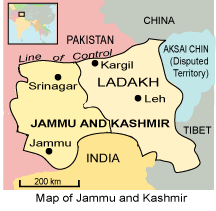Rioting in the Indian state of Jammu and Kashmir, which appeared in mid-July to be ending, has gotten worse over the past several weeks.
A profound observation by American writer Richard Shelton neatly summarizes the recent violence: “wars occur because men want them/and peace occurs when they are tired” (Selected Poems, 1969-1981).
The people of that state are evidently not yet tired of fighting. While the Buddhist and Muslim peoples of Ladakh are not directly involved, except that they are residents of a mountainous district in the same state, the strife fosters a climate in which sectarian issues are solved by violence.
This news service reported on July 17th that the agitation began when the government of the state agreed with the Hindu Sri Amarnath Shrine Board to give it nearly a hundred acres of state forest land so it could provide toilets and huts for the thousands of pilgrims that visit the popular shrine each year. The Muslims of the Kashmir Valley protested violently until the state government canceled the plan. During the chaos in July, the central government in New Delhi replaced the elected state government and appointed a new governor.
 But canceling the planned facilities for the pilgrims inflamed the opinions of Hindus in Jammu, the largest city in the Hindu section of the state to the south of the Kashmir Valley. They began rioting to demand the restoration of promises that the land would be given to the shrine. Soon, predictably, the Muslims in Srinagar, the major city of the Kashmir Valley, were rioting to protest the rioting in Jammu.
But canceling the planned facilities for the pilgrims inflamed the opinions of Hindus in Jammu, the largest city in the Hindu section of the state to the south of the Kashmir Valley. They began rioting to demand the restoration of promises that the land would be given to the shrine. Soon, predictably, the Muslims in Srinagar, the major city of the Kashmir Valley, were rioting to protest the rioting in Jammu.
Last week passions became even more intense as the rioting continued to get worse. Police and army troops fired tear gas and bullets into crowds in both cities when appeals for calm failed to produce anything resembling the tolerance that had prevailed in the state over the previous couple of decades. Fortunately, the inter-religious violence that has wracked Ladakh in recent years has not—yet—been inflamed by this violence in the lowland part of the state.
Despite efforts of national party leaders to develop a truce that would allow passions to cool, local leaders are determined to not let the matter calm down. In Jammu, Hindu activists promised that the demonstrations would go on. “We will keep up the protests until the land is given back to the shrine,” said Leela Karan Sharma, leader of a Hindu group which is fomenting protests.
The Muslim minority in Jammu city live in constant fear for their lives and their homes. They claim that the police have not been protecting them. One leader indicated that “our homes are being torched,” though a police official retorted that they have only encountered “a few arson incidents.”
Prime Minister Manmohan Singh held emergency talks on Wednesday last week with a wide range of Indian leaders to try and find ways to end the rioting. But some politicians have not been optimistic. “This is the most polarised situation I have seen in a generation. I think before the situation is tackled, tempers have to cool down,” a member of parliament, Omar Abdullah, said at a press conference.
The Prime Minister’s meetings were not too productive, though at least a dialog process was begun. There was a shared perception among all participants that peace and normalcy had to be restored in both Kashmir and Jammu before the issue of proper facilities for hordes of pilgrims could be addressed.
Toward the end of last week, the news continued to be grim. The Indian army deployed 10,000 more troops in Jammu and Kashmir to help stop the rioting and the government placed top leaders of separatist movements under house arrest to prevent their participation in additional demonstrations.
The news continued to get even worse this week. On Monday, the blockade of the major highway into Srinagar and the Kashmir Valley, erected by Hindu protestors last week, prompted even more tensions and violence. The highway, through Hindu-controlled Jammu, is the only access into the Valley from India. Fruit growers in the Valley have been unable to ship out their produce, and supplies from the outside are getting scarce. The main highway up to Lakakh, from Srinagar to Kargil, is of course also unavailable to the rest of India.
Muslim activists decided to challenge the Line of Control, by marching toward Pakistan as a way of getting road access into their Valley. Army responses to the challenge, and incidents with Pakistan along the tense border, resulted in at least five more deaths, including that of a prominent, moderate, Muslim political leader, Sheikh Abdul Aziz.
“We will spill blood for blood,” the supporters of the dead sheikh chanted when they carried his body away from the hospital. Clearly the killings by the army in the name of restoring order are only ratcheting up the violence, which is wiping away two decades of relative peacefulness.
Massive protests by Muslims in the Kashmir Valley on Tuesday, in defiance of curfews, prompted the police to fire into huge crowds, killing 10 more people in various communities and injuring scores more. The curfews seemed to be working yesterday, keeping people in their homes in the state’s major cities,though some news sources indicated that violence persisted.
But throughout the rest of India, Hindu activists demonstrated for a couple hours in the morning with massive blockades that shut down some road and rail traffic in Delhi, Mumbai, and numerous other cities.